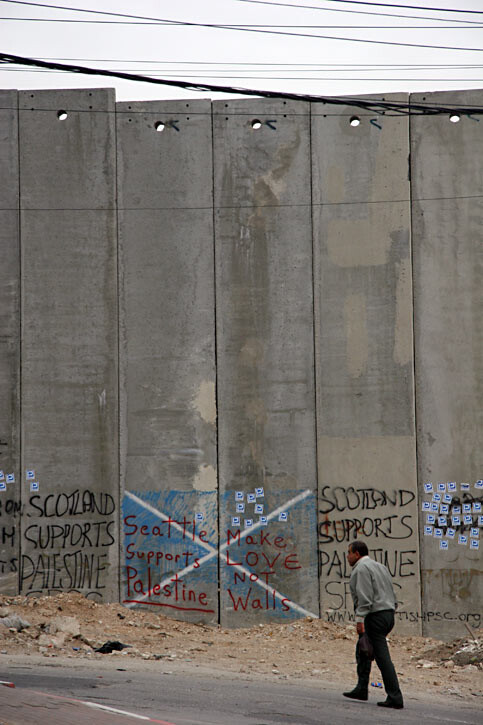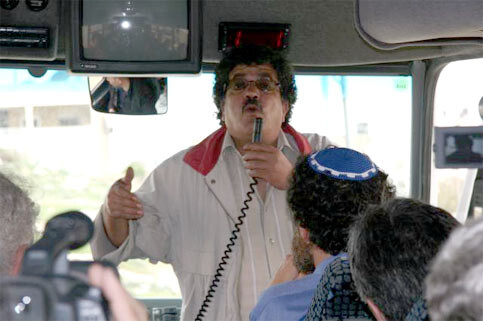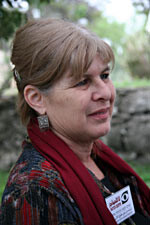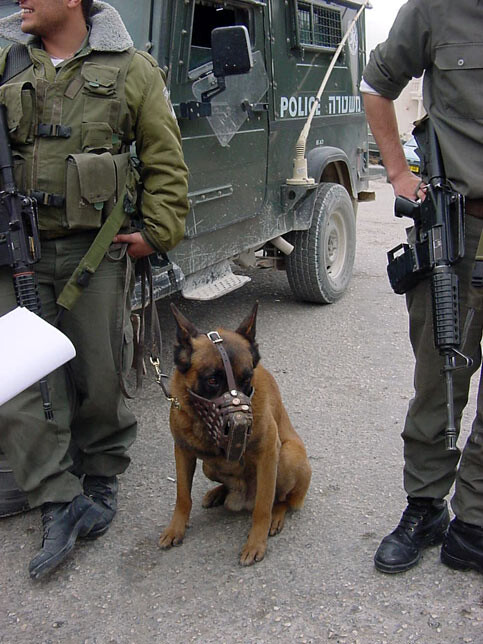Palestine 9 November 2005
March 7, 2005 in both East and West Jerusalem
Crossing the Bethlehem checkpoint is becoming routine; the absurd and surreal now somehow normal. All 19 of us flash our passports reflexively to the soldier, and we after waiting our turn in a line of cars, zip right through from Bethlehem to Jerusalem where ordinary local Palestinians are forbidden to go.
Israeli Committee against House Demolitions
We arrive at the Central part of West Jerusalem, just to the West of the Green Line in the Russian Compound. We are at the headquarters of the Israeli Committee Against House Demolitions (ICAHD), an Israeli group formed to resist the destruction of Palestinian homes by the Israeli Army. Its leader, Jeff Halper, is not available, so we are treated to the dynamic young Jewish-American activist Jimmy Johnson’s presentation about the current reality on the ground.

Jimmy Johnson from the Israeli Committee Against House Demolitions. (Bob Haynes)
During the Oslo process, the West Bank was divided up into Areas A, B and C. Area A was to be under Palestinian Civil and Military authority; Area B under Palestinian civil authority, but Israeli or joint military authority; and Area C under Israeli Civil and Military Authority. As the maps were drawn up for Camp David, 45% of the land in the West Bank became Area C, that is, under direct Israeli control, and under control of the settlements.
There are now more than 400,000 Israeli settlers in the West Bank if you include the settlers in East Jerusalem. Mr. Jones explains that there are two types of illegal Israeli settlements in the West Bank: The settlements of the extreme ideologically right-wing like Itamar, or Kiryat Arba’a, and the settlements of convenience, like Ma’ale Adumim, which have become Jerusalem and Tel Aviv suburbs, and are subsidized by the Israeli Government, be it Labor or Lukid. These large suburban settlements look like places in Southern California, with their own Ace Hardware’s, etc.
From the Palestinian perspective, East Jerusalem has represented 40% of the economy of the West Bank. As a result of the Wall and checkpoints, East Jerusalem’s economy is being systematically disconnected from the West Bank, and the West Bank’s economy is systematically being divided within itself through the Wall, the checkpoints and the lattice work of settlements and bypass roads which service them. Only 15% of the settlements are ideological; there are broader and more subtle forms of institutional racism inherent in the non-ideological suburban settlements.
The Wall disrupts Palestinian living patterns, separating Palestinians from each other. It is strangling the economy of the West Bank, and also Gaza.

The Wall. (Bob Haynes)
Johnson also described how Israel is the third largest defense contractor in the world. 20% of the United States’ foreign aide to the entire world during the past 30 years has gone to Israel. Currently Israel receives $3-5 Billion from the United States annually, with $2 billion in military grants for defense. Consequently, American taxpayers are bankrolling the widespread Israeli aggression that we see on the ground in the West Bank and Gaza today.
According to Jimmy Johnson, The Wall has resulted in fewer bombing attacks, but Qassam rocket attacks have gone up.

Rabbi Arik Ascherman from Rabbis for Human Rights. (Bob Haynes)
Rabbis for Human Rights
“In a democracy, some are guilty, but all are responsible.”
Rabbi Abraham Joshua Heschel, 1972
Next, our delegation meets Rabbi Arik Ascherman, who is the executive director of Rabbi’s for Human Rights (RHR). Rabbi Ascherman grew up in Erie, Pennsylvania in a Jewish family heavily influenced by Jewish religious tradition of human rights. Since immigrating to Israel, he naturally gravitated to civil rights issues; RHR also addresses poverty and social issues within Israel. Rabbi Ascherman practices civil disobedience “as a last resort.” He is currently awaiting trial in Israel for acts of civil disobedience, such as standing in front of bulldozers to prevent the demolition of Palestinian homes.
According to Rabbi Ascherman, there is a wide disconnect in Israeli society with regard to moral issues. “Everybody has their psycho-spiritual map, and everyone seems to limit their psycho-spiritual map.”
He feels that we are at a juncture of cautious optimism, with regard to the prospects for peace. He believes that Palestinians and Israelis on both sides of the conflict have learned the lessons of the breakdown of the Oslo peace process.
A majority on both the Israeli and Palestinian sides know that the compromise will be the Clinton plan, plus or minus a few details.
Since the breakdown of negotiations at the end of the Clinton and Barak administrations, a majority on both sides tacitly supported violence as a way to push the peace process forward. During Oslo, the Palestinians grew frustrated with endless negotiations that lead nowhere, as Israel continued building settlements and changing the facts on the ground, and the tendency to fight back using violence was overwhelming. Unfortunately, the violence of the second intifada decimated the peace and justice movements in Israel.
“Terror does not move peace forward,” according to Rabbi Ascherman, “while at the same time, Israel cannot negotiate peace, while systematically violating the human rights of Palestinians.” Both sides need to learn from the mistakes of the past to move forward.
Rabbi Ascherman takes us to the Palestinian village on the outskirts of Northeast Jerusalem known as Isawiya. It is in the shadows of the French Hill neighborhood, now heavily populated by Israeli settlers, and in the shadows of Mt. Scopus/Hebrew University. Before 1967, Isawiya included more than 12,000 dunams (aprox. 3000 acres) of land. Since the Israeli occupation of the West Bank and East Jerusalem, their land has been expropriated, for Israelis only, by about 95%. Now only 666 dunams, or 142 acres, are left, and only two-thirds of this is zoned for building.
This has been part of Israeli settlement of East Jerusalem, known as “the ring around Jerusalem.” Because of strict zoning regulations by the Israeli authorities, many Palestinians, unable to get building permits, have built anyway, and their homes have been slated for demolition. Acquisition of occupied land is a direct violation of the 4th Geneva Convention.
We travel through the Palestinian refugee camp of Shuffat, just East of Jerusalem, to the home of Salim Shawamieh, whose home has been destroyed and rebuilt four times!

Salim Shawamieh, whose home in Shufat Refugee Camp has been destroyed and rebuilt four times. (Bob Haynes)
Mr. Shawamieh explains to our group, “Imagine sitting there, having a meal with your family. All of a sudden, you are surrounded by troops, and tear gas is thrown into your home, forcing you to evacuate. This is ‘ethnic cleansing’, ‘a quiet transfer’, making our lives horrible.”
Rabbi Ascherman believes he is working for a better Israel. He is part of the Israeli and Palestinian “coalition of hope”, planning for a better future. “But I have had my share of death threats,” he says.
Palestine-Israel Journal

Hillel Schenker. (Bob Haynes)
Its co-editor is Ziad Abu Ziad, a Palestinian who lives in a town called Nasarriyeh in the West Bank. It used to be only a short 10 minute drive away from their main office in East Jerusalem, but now Nasarriyeh is behind The Wall and the Checkpoints, so now it takes more than 45 minutes, if you are lucky. Mr. Abu Ziad holds a West Bank identity card, which means he can no longer come to Jerusalem, unless the Israeli authorities grant him specific permission to visit, which almost never happens. So unfortunately, Mr. Abu Ziad cannot be with us today.
Palestine-Israel journal is published quarterly in English. It is 128 pages, half of which is devoted to a central theme. Thanks to e-mail, cellular phones, and virtual cyber-meetings, the two editors can carry on, even when they are unable to meet. Such is life building bridges in spite of the difficulties of movement in Jerusalem, where 3 faiths are concentrated and locked in a cycle of intimidation and violence.
This is unfortunate according to Mr. Schenker, who believes that the Israelis and Palestinians were only 2 weeks away from a final agreement in January, 2001 at the end of the Clinton and Barak administrations. Then Bush and Ariel Sharon came to power, and warm relations of the two sides deteriorated significantly.
Now according to Schenker, most Israelis in Tel Aviv cope by blocking out the reality on the other side. Meanwhile, the economy has plummeted on both sides. The Israeli economy continues to be propped up by American aid, while the Palestinian economy has fallen apart. Mr. Schenker still believes the ultimate solution will be based on the pre-1967 borders, perhaps with a few land swaps where the Palestinian state is given comparable lands in Israel in exchange for a few of the larger settlement blocks that Israel has built in the West Bank.
Machsum Watch

Nurit Steinfeld. (Bob Haynes)
According to these women, “the Army listens to us.” Machsum Watch had been able to reduce the number of out-and-out human rights abuses at the checkpoints; however this has produced ambivalence with regard to their purpose.
“We don’t want to improve the occupation; we want to put an end to the occupation.” Machsun published pictures and reports in Israel about a Palestinian man at a checkpoint being forced at gunpoint to play his violin. “Play something sad.” The soldier said. This story had a great impact on the conscience of many Israelis, even though no-one died in this incident. But it brought back memories of the Nazis in occupied Poland during WW II, who forced Jewish violinists to do the same thing before killing them.
We are taken to Abu Dis, a once upscale Palestinian suburb of East Jerusalem, where the wall is now separating Palestinian residents from their jobs, their schools and their health facilities.

A section of the Wall at Abu Dis where Palestinians squeeze through a small hole to travel between home and work. (Bill Dienst)
We watch as people climb up and squeeze through a gap in the wall where they are met on the Jerusalem side by Israeli Police, who are accompanied by an attack dog, and a Palestinian collaborator/Informant who gets special privileges for pointing out who, among the Palestinians passing by, should be singled out for interrogation and/or detention. This wall is completely destroying the economic viability of Abu Dis.

Israeli soldiers and attack dog at a section of the the Wall in Abu Dis. (Bill Dienst)
Next, we travel to the southeast border of municipal Jerusalem to the Palestinian village of Al Walaja. This village is now in a precarious situation, due to its strategic position. It interrupts the territorial continuity between West Jerusalem, and the Gush Etzion block of settlements, constructed since 1967 in the Southern part of East Jerusalem, which was conquered in the 6 day war.
In Al Walaja, the land has been designated as in the municipality of Jerusalem, but the villagers carry Palestinian ID passports, and are considered residents of the Palestinian territories.
“An absurd situation is thus created. The land is in the jurisdiction of Jerusalem/Israel, but the villagers … are considered as from the Palestinian territories. As such, they are banned from entering Israel. Simply by living in their own homes, they are in breach of the law, and face penalties and expulsion.”
Recently, the Israeli authorities have destroyed over 20 buildings and issued demolition orders for about 30 more, due to lack of building permits, which of course, are not issued to Palestinians.
Additionally, Al Walaja residents are subjected to incessant harassments due to the unfortunate location of where they live. These harassments include night arrests (since they are forbidden to live in their own homes, which are situated in an area of Jerusalem), imposing extortionate fines for unlicensed building, demolition orders, blocking of roads, vehicle confiscations, threats and intimidation. All of this is designed to impoverish the inhabitants of Al Walaja, and induce them to abandon there homes and give up their land.
Next part: Our dinner with Mordechai Vanunu.
Dr. Bill Dienst is a rural family and emergency room physician from Omak, Washington, USA. In March 2005, he traveled to Palestine and Israel as part of a delegation sponsored by Washington State Physicians for Social Responsibility (WaPSR). The delegation met with prominent Palestinians as well as members of the Israeli peace movement. They also traveled inside the Kiryat Arba’a settlement to hear a prominent member of the settler movement. In this series of articles, Dr. Dienst describes these meetings. Dr. Dienst has been to Israel-Palestine twice before. In November 2003, he spent 10 days in Gaza sponsored by Gaza Community Health Programme, and in 1985, he spent 4 1/2 months in Egypt the West Bank and Gaza sponsored by the Palestine Red Crescent Society.





